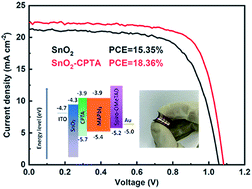Highly efficient flexible MAPbI3 solar cells with a fullerene derivative-modified SnO2 layer as the electron transport layer†
Abstract
Flexible solar cells represent a unique field in which hybrid perovskites may find complementary application to silicon solar cells. However, significant challenges in the fabrication of electron transport layers and hole transport layers at low temperatures have been imposed for perovskite solar cells since flexible substrates typically cannot withstand high processing temperatures (>150 °C). In this study, a low-temperature (140 °C) processed SnO2 layer was adopted as the electron transport layer in perovskite solar cells on a flexible PEN (polyethylene naphthalate) substrate, and a fullerene derivative with a carboxylic group (CPTA) that modified the interface between SnO2 and MAPbI3 was found to significantly improve the device performance. The beneficial effects of interface modification on increasing the carrier selectivity to electrons were elucidated, which resulted in a power conversion efficiency of 18.36% for the solar cells under simulated AM1.5 sunlight. The flexible solar cell still retained 75% of its initial efficiency after 500 cycles of bending with a curvature radius of 5 mm. The MAPbI3 solar cells were stable under ambient air conditions (25 °C, 30% relative humidity), and 87% of the initial efficiencies were retained for the unencapsulated devices after 46 days of storage in ambient air.



 Please wait while we load your content...
Please wait while we load your content...